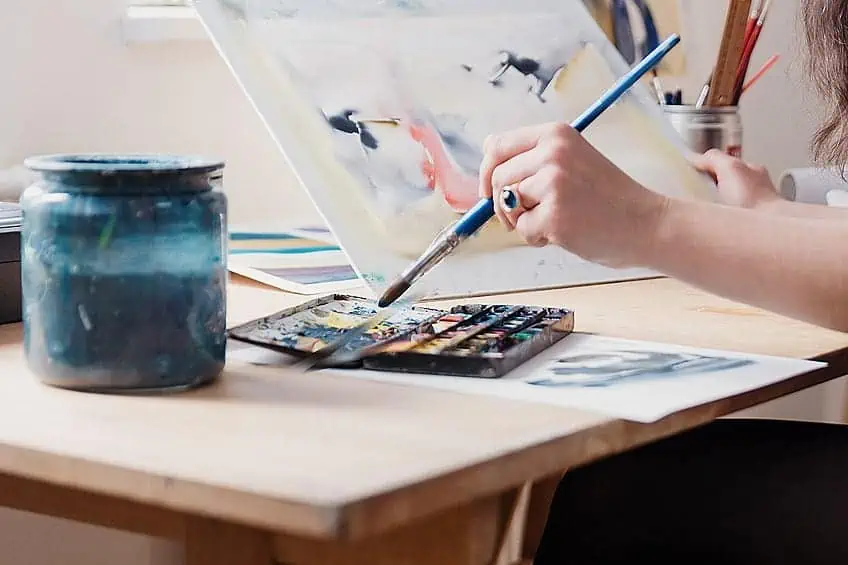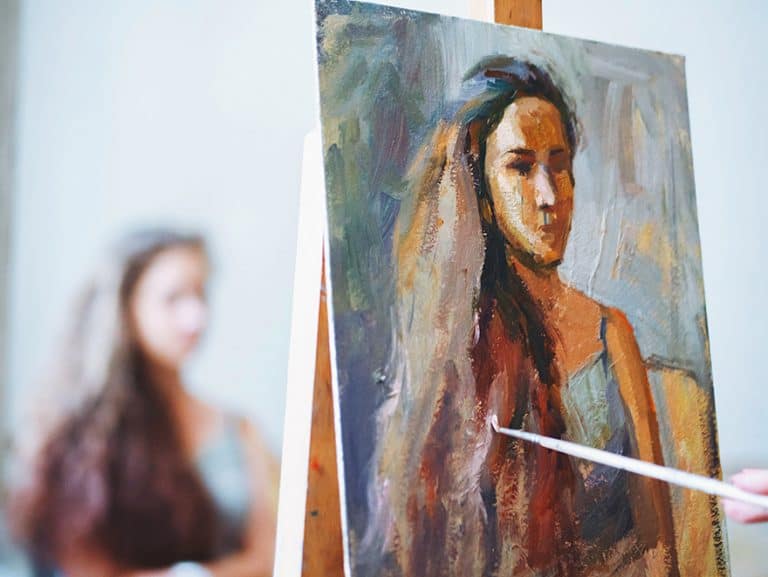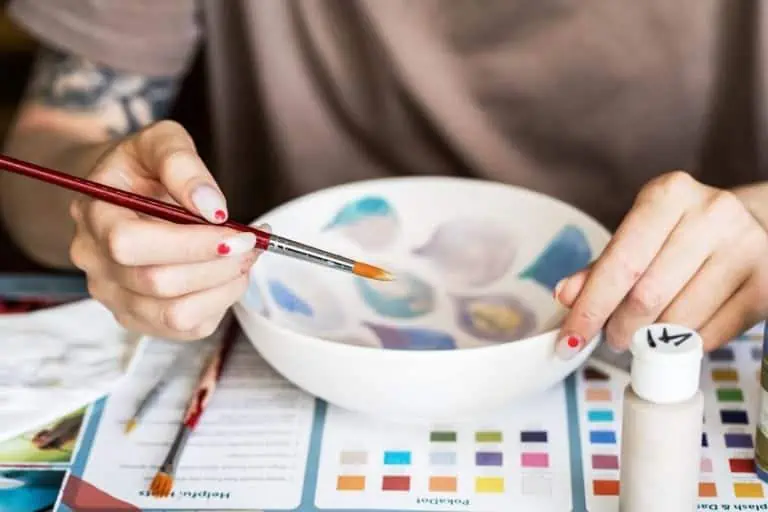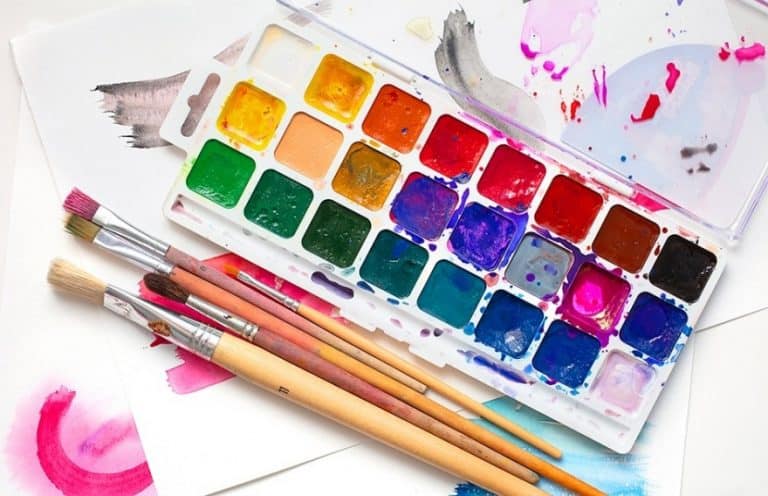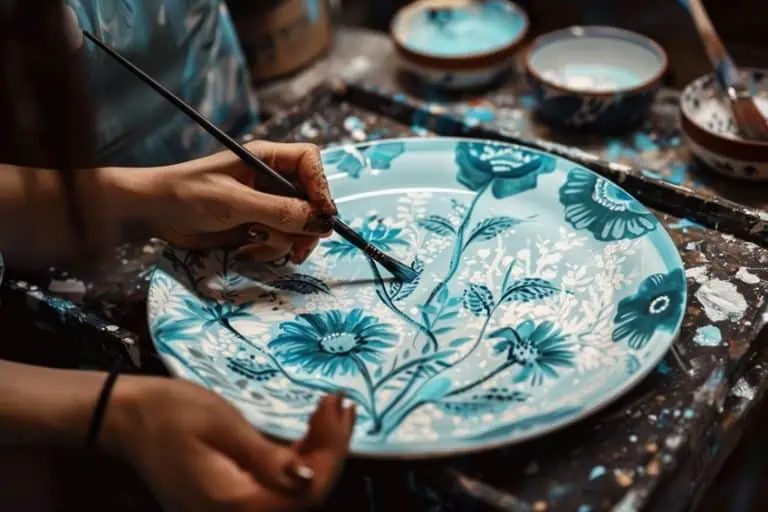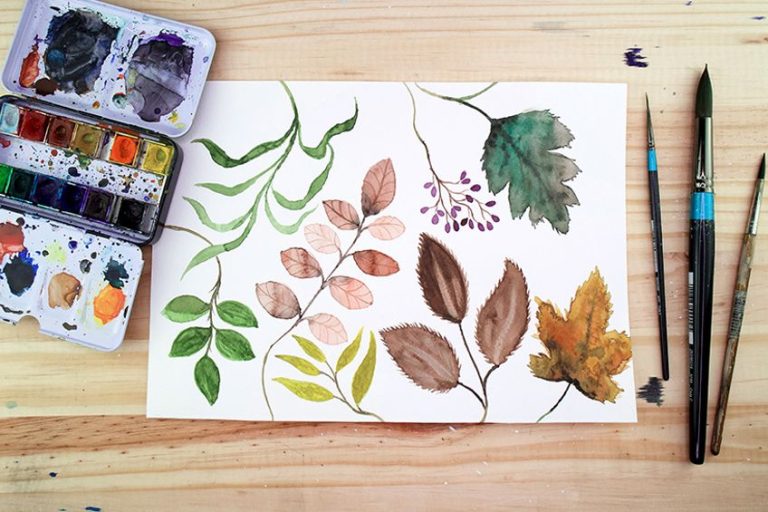Can you Use Watercolor on Canvas – Your Complete Guide
This post may contain affiliate links. We may earn a small commission from purchases made through them, at no additional cost to you.
Canvas has been one of the most favored materials to be used in the painting world. So many different kinds of paints can be used on canvas – you might wonder what the limit is. For today, our focus is more on the questions, Can you use watercolor on canvas? The answer is a resounding yes! It only depends on the type of canvas you use, certain paints work best with a particular kind of canvas. If you are wanting to start painting your watercolor paints on canvas, there are a few things we must go through so you fully understand the material. This article will discuss all of the tricks to the watercolor painting on canvas trade, including preparing canvas for watercolor, and the best watercolor paints for canvas.
Table of Contents
- 1 Watercolor Painting on Canvas
- 2 Buying the Right Watercolor Canvas
- 3 Recommended Canvas for Watercolors
- 4 Painting With Watercolor on Canvas
- 5 Watercolor Painting on Canvas Suggestions
- 6 Frequently Asked Questions
- 6.1 Can Watercolors be Painted on Canvas?
- 6.2 Can I Draw the Picture I Want to Paint before I Paint it with Watercolors?
- 6.3 Must I do any Preparation to Pre-treated Watercolor Canvas?
- 6.4 What are the Three Different Types of Watercolor Canvas Available?
- 6.5 Can Watercolor Canvas Handle Mixed-Media?
- 6.6 What is a Watercolor Ground?
Watercolor Painting on Canvas
Are you wanting to step up our game and move your watercolor painting from paper to canvas? If the question, can you use watercolor on canvas, has crossed your mind at some point, you can rest easy because the answer is a resounding yes! The only thing you need to consider is that the typical canvas is not absorbent at all, in fact, quite the opposite.
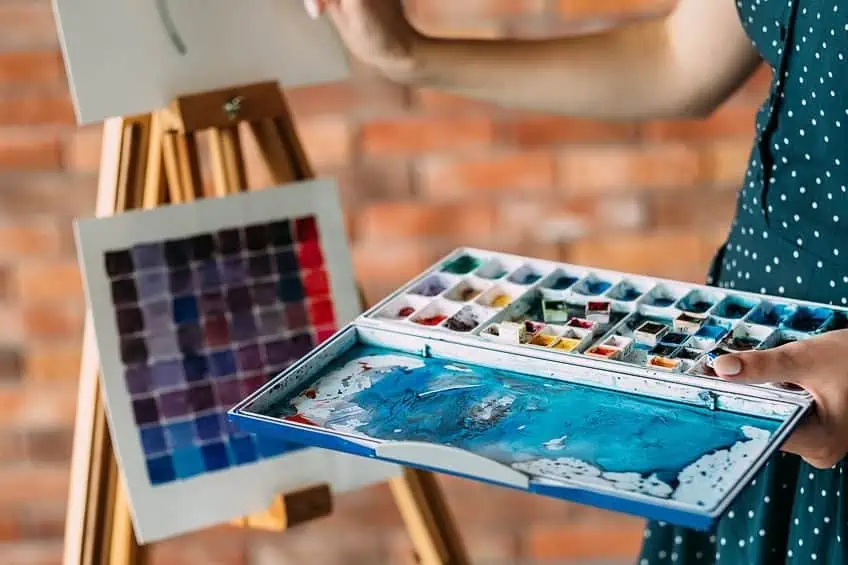
This means you either need to look out for a canvas that is specially treated, before you buy it, to be able to absorb the watercolors. You can do this yourself as well. When you purchase a normal canvas, layer it with a few coatings of gesso -this makes the canvas surface more absorbent. Always have a look at the gesso drying time.
Ups and Downs of Watercolor Canvas
Watercolor paints do not have much structure, like oil-based paints and acrylic paints. Its name gives itself away and its consistency is just like that of water. This means it needs more support from the material it is painted on to hold its form. The specialized paper for watercolor is very absorbent and porous so it holds the watercolor strong. Can you use watercolor on canvas?
If you have treated the canvas to become more absorbent, you can. Otherwise, the canvas is usually more liquid resistant and the watercolor paints will not hold. What follows next are the advantages and disadvantages of watercolors canvas art.
PROS
- If you are a slow worker, biding your time to blend your colors, watercolor on canvas board will not dry up as fast as if the watercolor were painted on paper which is very absorbent.
- Canvas is friendly to the environment because it is made of cotton 100%
- If you are clumsy, watercolor painting on canvas is more durable and will not break as easily
- Watercolor canvas can easily be mounted on a wall because it is often framed whereas watercolor paper will have to be framed once you are completed the painting
- Watercolor paper tends to warp at the edges – this is not something you will experience with painting with watercolor on canvas
- If you apply a layer of gesso to any canvas, you will end up with a canvas fit for watercolors.
- If you do not like the work you have done, you can wash the watercolor paints right off the canvas, whereas, watercolor paper, you work is permanent because the paper is so absorbent
CONS
- As the watercolor paints can be easily washed or lifted off the canvas surface, you have to paint an acrylic paint that is clear over the final piece to protect it from being washed off accidentally.
- Even if you are an expert at painting with watercolors on paper, you will have to redevelop your watercolor painting skills to work with canvas -the two material surfaces are completely different.
- Watercolor canvas art techniques might be tricky to learn because of how easy it is to be washed off the canvas
- Because the canvas is not as absorbent as the watercolor paper, you might experience pooling of the watercolor paints
If you are wanting to step up your game by working our watercolor paints on canvas, we suggest strongly, to get a little bit of practice before you attempt a large artwork. Try with smaller canvases and work with the different techniques until you feel confident in your skills and how the watercolor paint works.
Buying the Right Watercolor Canvas
On your next mission to the art supply store nearest to you, keep an eye out for those specialized canvases, specially treated to be able to absorb watercolor paints. Watercolor paper is much softer and far more absorbent, this is why preparing canvas for watercolor is important – if you did not manage to purchase the right canvas. In the store, the right canvas will explicitly state on the label if it is designed for watercolor painting. If not, a good thing to look out for is if the canvas is free of acid and made of cotton 100%.
If you do not have the luxury of buying another can, or maybe you are starting and do not wish to spend money on a practice round. You can always take a normal canvas, designed for acrylic or oil-based paints, and treat it by painting a layering of gesso over the surface. Painting watercolor on gesso treated canvas helps the paint to be absorbed better by the canvas.

Gesso is a chalk-like primer that has binding properties. Some people prefer to use an absorbent ground product. IF you are worried about how easy paint is to wash or lift-off. You can finish your painting off with a layer of transparent varnish or acrylic.
Recommended Canvas for Watercolors
Ultimately do have the choice to either put the effort into preparing your canvas to be able to work with watercolor, or buying the canvas that comes fully prepared – just purchase and paint. Below, for your benefit, we have listed out recommended canvases that are suitable for watercolor painting.
Most Advisable Watercolor Canvas: PHOENIX Cotton-Stretched Canvas
This canvas, certified by AP and CE, has amazing qualities of absorption, promising to hold on to watercolor paints effectively. It is made of 100% cotton and is particularly nifty if you need to correct it – because of its diffusion qualities. This canvas is not limited to working with watercolors, acrylics, oil-based, water-based paints can also be applied to its surface – and do not forget the tempera and the gouache paints!
Gesso is this canvas game – coming prepared with not one, or two layers, but three layers of gesso primer ensuring the watercolors stick beautifully. This canvas is not particularly heavy, this makes for easy transport – great for the traveling landscape artist Another benefit with this canvas is the paint colors being so vibrant.
- 100 % Cotton Watercolor canvas – Made from long-staple cotton
- Ntural texture, higher water absorbing ability, and excellent diffusion effects
- Also suitable for other water soluable painting materials, e.g, gouache, acrylic, pastels, and tempera
PROS
- Highly absorbent to water
- Comes already primed with gesso- ready to paint
- Beginner and advanced skill friendly
- Not very heavy – easily transportable
- Easy to display or mount on a wall
CONS
- Pooling may happen
Ultimate Watercolor Canvas Board: U.S ART SUPPLY Artist-Quality Panel Boards
If you are a newbie to watercolor art on canvas or a professional, and you are looking for professional or artist-grade canvas boards that work with watercolors – this is your next favorite painting surface, if you have not tried it already. These boards come prepped and primed for watercolor painting with three whole layers of gesso that are acid-free.
Watercolors are not the end of the game for this canvas, it works beautifully with most other paints including gouache, acrylic, tempera. If you are interested in spray painting or airbrushing, this canvas will also be a good option for you. These canvas boards are labeled as lightweight, weighing up to eight ounces.
- Each Panel is pre-primed and ready to be painted on
- 100% Cotton Canvas Surface - Hand Stretched and Glued Over High Quality MDF Cardboard Backerboards
- 1/16" Thickness Profile and 8-Ounce Triple Primed with Acid-Free White Gesso
PROS
- Three coatings of gesso primer
- Various size options to choose from
- Not heavy, transportable
- Beginner and professional friendly
CONS
- Not advisable for the pouring technique
- Frameless
Ultimate Watercolor Canvas pad: ARTEZA Foldable Watercolor Paper Canvas Pad
Like a sketchpad, but this is a canvas pad designated for painting. It is not limited to one type of paint efficacy, it works wonderfully with watercolor paints, acrylic paints, water or oil-based paints, and more. This product comes with instructions to construct a frame that is foldable for each of your artworks.
The heavier sheets are only about 300 grams in weight. This canvas pad’s sheets are particularly strong so buckling will not be an issue with your artwork. The sheets even come with a choice of either a hot-pressed finish or a cold-press finish -you’ll find both on either side of the sheets.
- Heavyweight Paper - 140 lb (300 gsm) cotton pulp sheets withstand multiple layers of watercolors
- Glue-Bound Pad - Each perforated sheet detaches cleanly from the pad
- Dual-Sided Sheets - These sheets include both textures so you can paint on whichever side you like
PROS
- Quite firm so it will not get damaged
- Comes with instructions to build a frame for your artwork
- Two different finishing textures on either side of the page
- Comes with multiple sheets
- Free of acid
- 100% cotton
CONS
- More costly
Painting With Watercolor on Canvas
Preparing the canvas to be able to absorb the watercolor will be discussed in this next detail. Make sure to read this before you start so that you do not skip any important steps. Painting watercolors on gesso is what makes the canvas suitable for watercolors. This section will help you when the only canvas you have access to are the normal canvases – the specialized watercolor pretreated canvases are new on the market so they might not be available everywhere.

Preparing Canvas for Watercolor
To enable the canvas of choice to be able to absorb watercolor paints, you need to prime it with a few coatings of gesso. This process is best accompanied by a treatment of absorbent ground. Both of these done before painting will set you off for a wondrous watercolor painting experience.
The absorbing ground gives the surface of your canvas a finish that is similar to a satin sheen. It intensifies the absorbing qualities of the canvas, which without any treatment would not absorb the watercolor paints at all. For your benefit, we have listed a few steps you can follow to properly prime your canvas for watercolor painting.
- You have the choice to paint only one layer of the gesso, but the more layers to add on, the more workable to watercolor will be with the canvas- it will absorb better
- You should aim for a minimum of two layers of the gesso – this is the standard recommended amount of layers for better absorption. As we said previously, one layer is sufficient but two are more efficient.
- If you prefer, you can always go right ahead with the absorbent ground and skip the gesso layers. Adding both, however, will improve the quality of your painting.
- If you choose to add both the gesso as well as the absorbent ground, make sure you wait the right amount of time for the gesso to dry properly
- When applying the absorbent ground, use a roller or a paintbrush – smooth out any bumps or lumps by dipping a brush in clean water and brushing gently over them.
- After waiting 24 hours to let all of the layers dry and set, you can finally begin to paint your desired picture with the watercolors.
- Once your painting is complete and it has finished drying, use a spray-on transparent varnish or a spray-on transparent acrylic paint to seal your artwork – protecting it from lifting off the canvas.
- If you choose a canvas with a wooden frame, you will be able to hang your artwork on the wall immediately – the clear varnish gives a shiny finish so there is no need to put it behind glass.
Sometimes you might notice that using absorbent ground leaves you with a slightly opaque, chalky look once the paint has finished drying. This can be avoided if you make sure you wipe down the dried absorbent ground before you start your watercolor painting. To do this, use a cloth that is free of lint and gently wipe away the chalky residue before you paint.
It is important to take note that the absorbent ground is what makes correcting any mistakes very easy. It does, however, cause the edges of your painting to bleed a little. It also makes the execution of small detailed pieces within your painting fairly tricky.
Watercolor Painting on Canvas: A Basic Tutorial
Once the above instruction has been followed, and your canvas has been appropriately primed with the gesso and the absorbent ground, you will hopefully be left with a surface that feels similar to watercolor paper – or similar enough. Of course, there will be some differences, but at least when it comes to the watercolor bloom, the wet-on-wet technique, and achieving strong lines and edges, it is very much the same.
Because you persevered and you completed the priming with gesso and absorbent ground steps, you will have the benefit and freedom to correct your mistakes within the watercolor painting you create. The absorbent ground is particularly responsible for that. You must also take care not to accidentally wash or lift any parts that are no mistakes.
You might find that the techniques you are most comfortable with when watercolor painting on paper, might need to be re-addressed. Practice will make your skills stronger, so do not be so hard on yourself when you first start and it feels like new territory. Glazing and smaller details are the trickiest when moving from watercolor on paper to watercolor on gesso-covered canvas.
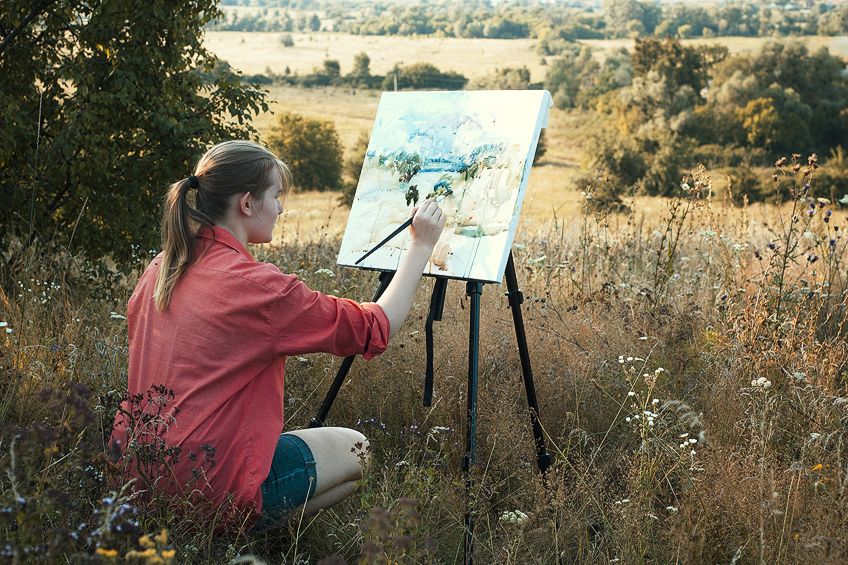
Unless you prefer to freestyle your art like a lot of landscape artists, your first step would be to draw the picture you wish to paint onto the newly primed and dry canvas. Using a pencil or a piece of white chalk, trace the outline of the picture. If there are any sections you do not want the paint to be on, stick down some masking tape, use a bank card or a paint scraper to make sure it is stuck down properly without any gaps.
If you have made any errors, like forgetting to put the masking tape down and the paint crossed over a line it should not have, you can always lift the error by picking at it with either a spatula, paint scraper, toothpick, or earbud. You do not need to worry about damaging the canvas like you would with paper. The canvas is much thicker and it is resistant to warping, curling in at the edges, or getting saturated from too much watercolor paint. It may be a little bit trickier to use your common watercolor brushes because of the brought structure of the canvas.
The benefits you experience with the gesso and the absorbent ground making it easy to clean up any mistakes, it also means that protecting your finished artworks is of paramount importance. To do this, you can spray on a coating of a varnish that is transparent. This will prevent any spills from staining your work or washing off the paint. A transparent acrylic spray paint will also be a brilliant protective option, if you can, make sure it is resistant to the sun’s UV rays.
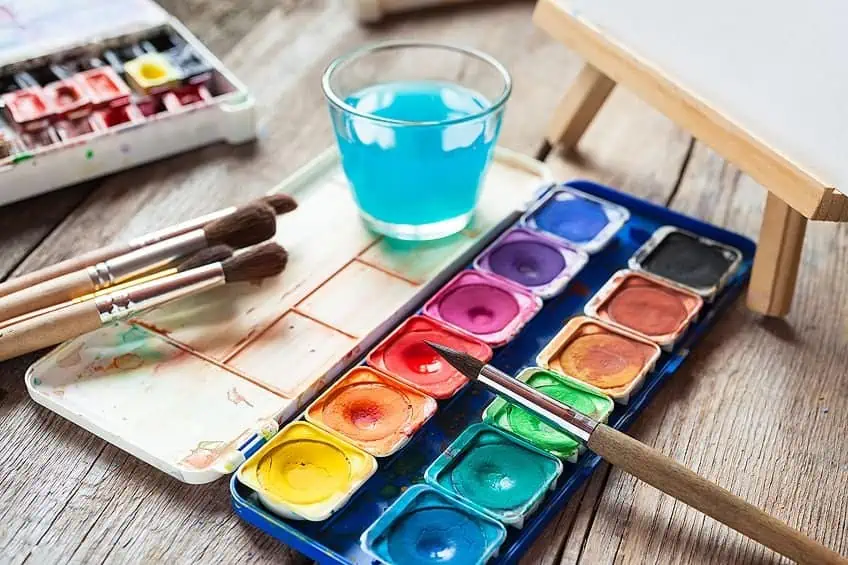
Watercolor Painting on Canvas Suggestions
Now that you know it is possible to use your watercolor paints on canvas, including how to prime your canvas before you start painting. Below we have listed a few further suggestions that might make your watercolor painting experience much more enjoyable.
- The most typical watercolor painting you will find within the artistry world is a picture of a serene landscape or a bouquet. Expressionists favor this art medium for how it reflects their inner feelings. Before the invention of the watercolor canvas, the paper was the only surface for watercolor paints and a lot of practice was involved to get the techniques just right. Now that you have the option, there is more freedom to clean up the mistakes and keep trying, without the frustration of having to start from the beginning and waste resources.
- After you have finished with your watercolor piece, there is a waiting time of 24 hours before you can add on the transparent varnish or acrylic paint coating. This is an important step because it keeps the painting from being washed off accidentally. Read the label of the varnish or paint you choose to work with so you know the right amount of time it takes to dry.
- When applying the transparent varnish or acrylic paint, make sure it is a spray-on method. A brush-on method tends to lift the artwork you are trying to protect.
- You do not have to paint the transparent varnish on immediately, you can wait a week or two if you are not 100 percent convinced that your artwork is complete. Make sure you store it in a place where it is out of the way from any bumps or splashes.
- If you are not a fan of the chalky texture the absorbent ground leaves you with you can get a piece of sandpaper that has a particularly fine grit and lightly sand it down. Then finally, take a cloth that is free of lint and wipe up the residue left behind.
Before the invention of watercolor-ready canvases, the only option that watercolor painting artists had was watercolor paper. Where this did offer easy transportation and promoted the vibrant, yet pastel, hues of watercolor paint. As time went on, the art style evolved and more permanent structures were desired for watercolor artworks.
Canvas was the next best option which added a more durable and long-lasting element into the style. There is the option to prepare the canvas with gesso and absorbent ground yourself, or you can buy pretreated canvases.
Frequently Asked Questions
Can Watercolors be Painted on Canvas?
On a normal canvas that is designed for the typical paints, like oil-based, latex, or acrylic paints, you will struggle to get the paint to absorb onto the painting. You must lookout for a canvas that has been specially treated with a coating or three of gesso and absorbent ground. This helps the watercolor paints to be absorbed into the canvas.
Can I Draw the Picture I Want to Paint before I Paint it with Watercolors?
If you are not a fan of free expressionist artistic style, you can use a pencil to outline your painting’s picture. This will help you with the proportions of the picture.
Must I do any Preparation to Pre-treated Watercolor Canvas?
You do not have to do anything besides start painting. The benefit of purchasing a pretreated watercolor canvas is that there is no preparation work to do before you can start the painting.
What are the Three Different Types of Watercolor Canvas Available?
If you are looking to buy canvas for watercolor painting, keep an eye out for three different types and see which one would work for you best. There are canvas pads, the canvas that has been stretched, and canvas boards.
Can Watercolor Canvas Handle Mixed-Media?
When working with watercolor paper, mixed media was not an option because the paper is more fragile and prone to damage. When working with watercolor canvas, no matter the form of canvas you choose, you can use mixed-media in your art because the surface material is more durable.
What is a Watercolor Ground?
The watercolor ground is also known as absorbent ground. This is another layer of the preparation you must do for the canvas to be able to accept the watercolors. If you avoid this step, the gesso would be fine, but the optimal absorption of the watercolors comes if you use both gesso and absorbent ground. The watercolor ground must be left for up to 48 hours before you can start your painting, to ensure it has fully dried.
Matthew Matthysen is a multidisciplinary artist. He completed his fine art degree, majoring in History of Art and Contemporary Drawing Practice at the University of Witwatersrand, South Africa. Before joining acrylgiessen In 2020, Matthew worked part-time as an art teacher at Reddford Blue Hills High school. Matthew creates drawing and painting tutorials for acrylgiessen and captures them not only photographically and in written form. He also records the creation of his works in his own creative studio as in video format, from which later with a voiceover and a video editor also drawing tutorials for the Youtube channel of acrylgiessen are created.
Learn more about Matthew Matthysen and about acrylgiessen.
